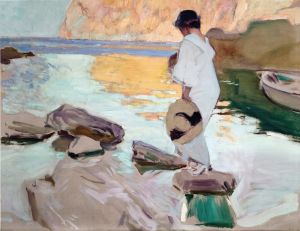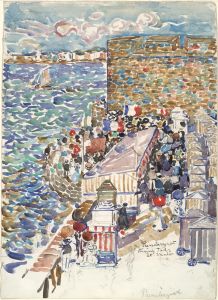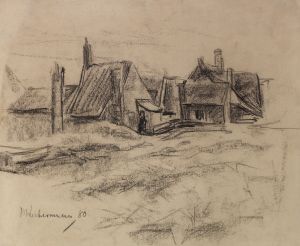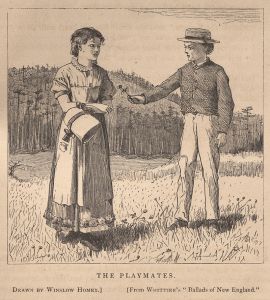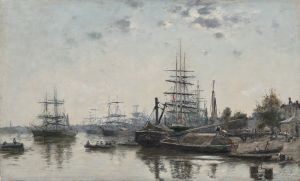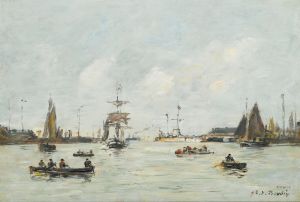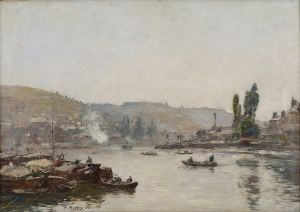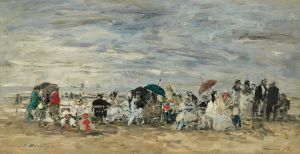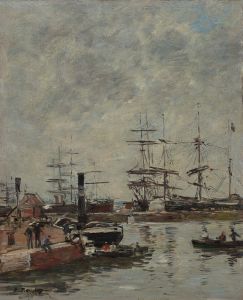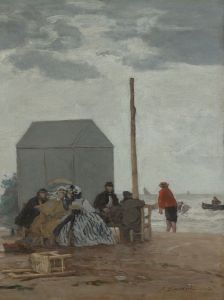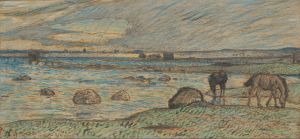
On the Beach,Trouville
A hand-painted replica of Eugène Boudin’s masterpiece On the Beach,Trouville, meticulously crafted by professional artists to capture the true essence of the original. Each piece is created with museum-quality canvas and rare mineral pigments, carefully painted by experienced artists with delicate brushstrokes and rich, layered colors to perfectly recreate the texture of the original artwork. Unlike machine-printed reproductions, this hand-painted version brings the painting to life, infused with the artist’s emotions and skill in every stroke. Whether for personal collection or home decoration, it instantly elevates the artistic atmosphere of any space.
Eugène Boudin was a French painter born on July 12, 1824, in Honfleur, France, and is often regarded as one of the precursors to the Impressionist movement. He is best known for his seascapes and beach scenes, capturing the essence of the French coastline with a particular focus on the changing effects of light and atmosphere. One of his notable works is "On the Beach, Trouville," which exemplifies his skill in depicting outdoor scenes with a sense of immediacy and naturalism.
"On the Beach, Trouville" was painted in the mid-19th century, a period when Boudin frequently visited the Normandy coast, particularly the towns of Trouville and Deauville. These locations were popular seaside resorts during the time, attracting tourists and artists alike. Boudin was captivated by the lively beach scenes and the interplay of light on the water and sand, which he rendered with a delicate touch and a keen eye for detail.
The painting showcases Boudin's ability to capture the transient effects of light and weather, a hallmark of his work that would later influence the Impressionists. In "On the Beach, Trouville," Boudin employs a soft, muted palette to depict a serene beach scene. The composition typically includes elegantly dressed figures strolling along the shore, a common sight in the fashionable beach resorts of the era. The figures are often portrayed in a relaxed manner, enjoying the leisure activities that the seaside offered.
Boudin's technique involved painting en plein air, or outdoors, which allowed him to observe and record the natural environment directly. This approach was somewhat revolutionary at the time and laid the groundwork for the Impressionists, who would adopt and expand upon this method. His brushwork in "On the Beach, Trouville" is loose and fluid, capturing the movement of the figures and the gentle breeze coming off the sea.
The sky in Boudin's beach scenes often plays a significant role, and "On the Beach, Trouville" is no exception. The expansive sky dominates the composition, filled with soft clouds that suggest a breezy, pleasant day. Boudin's ability to render the sky with such depth and luminosity adds to the overall atmosphere of the painting, creating a sense of openness and tranquility.
Boudin's work was highly regarded by his contemporaries, including Claude Monet, who once referred to Boudin as his "master." Monet's own development as an artist was significantly influenced by Boudin's approach to capturing light and atmosphere. Although Boudin never fully embraced the Impressionist label, his contributions to the movement are undeniable, and his beach scenes remain celebrated for their beauty and technical skill.
"On the Beach, Trouville" is a testament to Boudin's mastery of capturing the ephemeral qualities of nature and his ability to convey the leisurely spirit of the 19th-century French seaside. His work continues to be appreciated for its pioneering approach and its role in the evolution of modern art.





